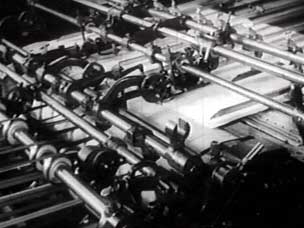 |
The black press . . . running.
From Soldiers Without Swords: The Black Press. |
|
The community room of St. Mary's Catholic
Church in Houston was packed with angry residents wanting to know what the
police were going to do about the infamous crack house in the neighborhood.
Police Chief Lee P. Brown called this meeting of church and community members
to assure them the department was on the case. A week earlier, during recess
at the church school across the street, a drug-deal-gone-bad resulted in
a shootout at the house. On that March evening in 1987, Brown and members
of the audience engaged in a spirited discussion about crack houses and
drugs in the community. I covered the event as a reporter for the weekly
African American newspaper, The Informer and Texas Freeman, where
I was also managing editor. As I sat in the front row with other members
of the media, a white reporter from one of the daily newspapers leaned over
and asked me where the crack house was located. Surprised at his lack of
knowledge, I told him it was across the street from the church and the church
school. Everyone in the room, except those not from the community, knew
exactly where the house was. Those in the black media knew. Because the
problem affected the African American community first, here, as elsewhere,
the black press led the media charge that uncovered the problem of crack
cocaine in the early to mid-1980s—long before the mainstream media.
Today, the black press continues to lead the coverage of issues and events
in the black community.
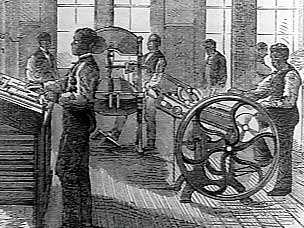 |
19th Century black press printing shop.
From Soldiers Without Swords: The Black Press. |
|
That is the point that is missed in the conclusion
of the The Black Press: Soldiers Without Swords. Because the producers
erroneously dismiss the black press as now ineffectual and on its deathbed,
I begin this analysis with the end of the video. The white reporter's question,
and my reply, serves to illustrate the unique role the black press has played,
and continues to play, since its founding March 16, 1827.
As one who has literally scrambled for
most of my scholarly life for any scrap of information on the black press,
I greeted the announcement of the 1998 release of Soldiers with
glee—especially because there is so little awareness of the existence
and the significance of the black press. Stanley Nelson has produced a
useful documentary about an important institution in the black community,
though I disagree with his conclusion and take issue with the film's limited
breadth. Soldiers Without Swords fails to fulfill its suggested
promise of comprehensiveness. It ends its account of the history of the
black press in the late 1960s or early 1970s, suggesting that the black
press in the United States is now essentially dead. If this was not a
deliberate suggestion, the video would benefit from a clear explanation
of its intended scope. The lack of clearly defined temporal parameters,
combined with the assertion of the death of the black press, creates confusion
about the scope of the project.
Despite these shortcomings, there are
some good things about Soldiers Without Swords. It is evident that
much work went into the research and production of this documentary and
its accompanying CD-ROM. Together, through an examination of the black
press, they chronicle selected aspects of the social and political history
of African Americans from the late 1820s to 1975. Because of the scarcity
of available information on the black press, this, no doubt, was a difficult
task.
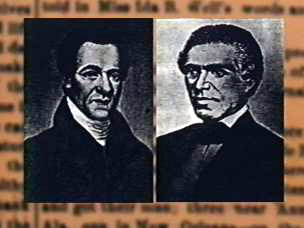 |
Samuel Cornish (left) and John B. Russwurm (right).
From Soldiers Without Swords: The Black Press.
28.8K | 56K | Cable/T1 |
|
Early on, the documentary correctly sets the
tone as it describes the history of the black press as the first independent
voice for African Americans in the United States. It notes that the odyssey
of the black press began when John B. Russwurm and Samuel Cornish published
Freedom's Journal in New York City after a white publisher refused
to publish African American responses to a series of articles that scandalized
the city's black population. It chronicles in five sections the role of
the black press during selected historical moments: the development of Freedom's
Journal during the abolition movement, the role of the black press during
the migration of blacks from the South, how African American newspapers
helped blacks adjust to life during the segregation period, the dilemma
blacks faced when asked to fight in World War II while being denied full
citizenship, and finally, what the filmmakers present as the decline of
the black press in the face of the civil rights movement. The video is easy
to watch, and engaging on the issues covered.
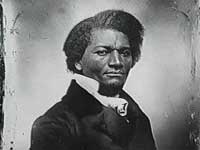 |
Frederick Douglas, editor of
The North Star. From Soldiers Without
Swords: The Black Press. |
|
The producers effectively hold the video together
with still photos of important political and social heroes of black history
including editors, activists, entrepreneurs, and entertainers. Mastheads
of past issues of black newspapers, archival film of urban areas and rare
behind-the-scenes shots taken at black newspapers, and newsreels of the
day also help tell the story of the black press. Narratives from black press
historians, such as Jane Rhodes and James Grossman, and black journalists,
including syndicated columnist Vernon Jarrett and longtime Jet Magazine
reporter Phyl Garland, add a "live" perspective that makes the video interesting.
I wish the producers had identified these speakers more thoroughly. In too
many cases, their affiliations were not noted. As a scholar and journalist,
I want to know their background, including their institutional or professional
affiliations.
The video highlights the efforts of such heroes
as black press founders Russwurm and Cornish, abolitionist and North
Star newspaper editor Frederick Douglass, California Eagle publisher
Charlotta Bass, and publishers Robert Abbott of the Chicago Defender
and Robert Vann of the Pittsburgh Courier. Their newpapers served
as beacons for millions of blacks in their migration from the South to the
North. Especially with Douglass, Bass and Vann, the video explains how black
publishers used their newspapers to further the political agenda of the
black community, both nationally and locally.
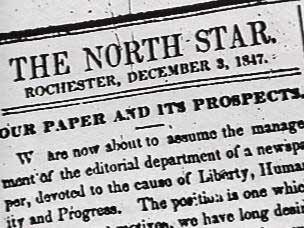 |
The North Star, established in 1847,
edited by Frederick Douglas. From
Soldiers Without
Swords: The Black Press. |
|
More of this is needed; the political role
of the black press is underplayed in Soldiers. There are also several
glaring gaps in period coverage in the documentary. Soldiers essentially
skips over the years during the development of, and immediately following,
the demise of Freedom's Journal in 1829. This was a critical time
in the development of black intellectual endeavors when free black people
were promoting political ideas of their own and forging, for the first time,
a national consciousness. This was a period when free blacks were building
community institutions. It was also during these years, for the first time
since Africans arrived on this continent, that blacks as a group split on
whether to seek assimilation or some form of black nationalism. The dilemma
first found expression when white abolitionists advocated colonization of
people of African descent. Most whites supported colonization while most
blacks opposed it. During this time—in the 1830s and 1840s—many
whites, believing themselves superior, felt Africans could not fit into
U.S. society. Advocates of colonization suggested that free blacks should
be sent back to Africa, to South America, the Caribbean, and to the American
West to live among themselves. This era set the stage for black spokespeople
like Frederick Douglass and Harriet Tubman to influence and energize the
efforts of the anti-slavery movement—increasing public pressure to
eventually end African bondage and, as more than a few have argued, laying
the foundations for the Civil War.
Soldiers Without Swords fails to show how
the black newspaper developed into an important ideological tool of the
free African American elite both before and after emancipation. Throughout
African American history, black political players owned or controlled black
newspapers, or were major editorial contributors. For instance, Booker T.
Washington owned interests in and financially supported several black newspapers,
including The New York Age. Soldiers doesn't fully address
this vital political role of the black press—a role that continues
today.
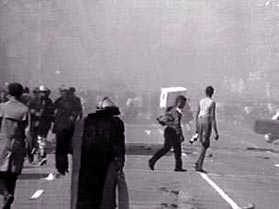 |
Riots of the 1960s. These riots opened opportunities
for African American reporters. Click below for
video segment explaining this.
28.8K | 56K | Cable/T1 |
|
There are still other issues that Soldiers
Without Swords fails to adequately address. The black press helped spark
and sustain such epochal movements in black history as the Harlem or Negro
Renaissance of the 1920s and the Black Power movement of the 1960s. To neglect
or minimize these movements denies the role of such newspapers as the Amsterdam
News in New York City, The Black Panther (of the Black Panther
Party), and Muhammad Speaks, published by The Nation of Islam—a
publication that the N. W. Ayers Directory of National Publications
listed in 1977 with an unaudited circulation of 850,000. Until that time,
the only other black publications to get even close were the magazines Ebony
and Jet, which Ayers listed in the same year with audited
circulations of 1,288,149 and 623,933, respectively. Neither of these publications
is mentioned in Soldiers Without Swords.
There is also no mention of the publisher of Jet and Ebony,
John H. Johnson, who in the mid-1940s was probably the first media owner
to see the financial importance of an emerging black middle class with
money to spend. It was Johnson who set the stage for the development of
a national black consumer market that first attracted corporate advertising
for black publications. Nor is there any acknowledgement of scholarly
publications like The Journal of Negro History or The Black
Scholar and the role they played in countering the claims of the eugenics
movement which used false scientific justification to advocate the superiority
of whites. Soldiers does not discuss the roles of the official
magazines of the NAACP, Crisis, and the National Urban League,
Opportunity, although these publications were essential in helping
to shape the political and intellectual ideas of this nation, especially
as they affected African Americans.
The black press is an important component
of the African American community, giving voice to the many needs
of its members, no less so than the mainstream press that trumpets the
concerns of the U.S. power elite. Yes, there are fewer readers. Yes, black
papers are no longer the main media for many African Americans. Yes, the
numbers of black publications go up and down depending on the social and
political circumstances of African Americans. Nonetheless, the black press
is no more dead than the white press. A look at some of the data underlying
these conclusions explains some of the limitations of Soldiers Without
Swords.
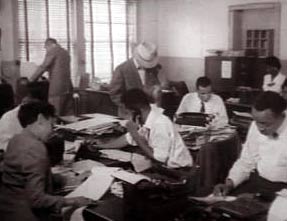 |
A black press room. From final segment of Soldiers
Without Swords. Click below for film's conclusion.
28.8K | 56K | Cable/T1 |
|
Based on my analysis of data in the Ayers
Directory, the black press is behaving as it has throughout its history.
A simple visual trend examination of the black press from 1900 to 2001 shows
the shifts in the number of black publications during this last century.
The number of newspapers has fluctuated from a low of 127 in 1937 to a high
of 333 in 1911. Circulation, for the most part, increased steadily. In 1965,
the point at which Soldiers seems to conclude, Ayers listed
156 black newspapers with a combined circulation of 3,112,060. Compare that
to the 230 black newspapers listed in 1999 when the documentary aired. The
latest edition of the newspaper directory published in 2001, now called
Gales Directory of National Publication and Broadcast Media, shows 247
black newspapers with a combined circulation of 14,477,927. Clearly, these
figures do not reflect the death of the black press.
In the final section of Soldiers Without
Swords, Putting Itself Out of Business,
the producers note that black newspaper circulation declined, yet there
is no discussion beyond 1965. Circulation fluctuated from 1.7 million
in 1957 to a high of 4.6 million in 1970. In 1973 circulation soared to
10 million, then to another peak of 13 million in 1976.
For the next eighteen years, circulation
would go up and down from the 1976 high until 1994 when the number again
would reach 13 million. Shifts in the circulation
and the numbers of black publications are typical of the black press.
Changing political and economic concerns of African Americans greatly
contribute to this fluctuation. A longitudinal study of the black press
is the best way to begin to understand its complex behavior. Although
there is a decline in print readership across the board, Editor and
Publisher reports there is actually an increase in circulation of
weekly and ethnic media. Circulation increases during the early 1970s
occurred following the launch of scores of city and regional publications
and several national black magazines—Essence and Black
Enterprise, for example.
We need to get away from simplistic analyses
of the black press that focus mostly on the protest or advocacy role of
African American newspapers. As a functioning institution in the black social
structure, the role of the African American press is more complex. George
McElroy, editor of The Informer and Texas Freeman, said it
best when he underscored the continued need for black newspapers: "We cover
issues that the major dailies don't see or fail to see. We're closer to
problems and concerns in our community. We see them first." McElroy, a retired
professor of journalism, credits his newspaper and other African American
newspapers with being the first to report on the dangers of the crack cocaine
problem, long before the issue became popular with mainstream media. On
this and other issues close to the hearts of African Americans, the black
media are regularly the catalysts that awaken mainstream media and local
politicians to critical issues in the community.The black press has also
been an alternative to and watchdog of mainstream media, influencing intra-
and inter-group opinion, and helping to maintain group unity. Little of
this is captured in the video.
 | |
Selection from timeline on the Soldiers Without Swords CD-ROM. |
|
The CD-ROM is the most intriguing aspect
of the Soldiers project. It has the potential, if properly used,
to fill in those areas that the documentary itself neglects. The CD presents
many subject areas, editors, and newspapers not mentioned in the documentary
itself. I particularly like the timeline with date entry points from 1827
to 1975 that one can click on to get more information about that period. On the
1837 timeline entry point, for instance, there is a link to a Web site
about the mutiny on the slave ship Amistad. This entry includes excerpts
of coverage of the incident by the black newspaper The Colored American.
The timeline also includes links to sites about black newspapers and events
that affected those newspapers and African Americans.
I asked my colleague, Professor Eddie Blick,
the department's "technology guru," to also examine the CD-ROM. He agrees
that overall the CD-ROM is an excellent supplement to the video. He noted
a need for bigger windows to view newspapers, as well as a a way for those
using Windows software to use the scrolling wheel on the mouse. Blick found
the navigation speed slow—it takes too long to navigate between sections.
We do not believe this problem is specific to our department computers.
Also, it would be helpful to have links on each screen that allow the user
to move forward without returning to the main screen of each section. There
is a technical problem under Untold Stories
where the user is urged to "Click here and hear for yourself." When you
click, there is no sound. We both agreed that in some sections, graphic
"noise" (visuals in the background) made it difficult to read type that
was superimposed on the images
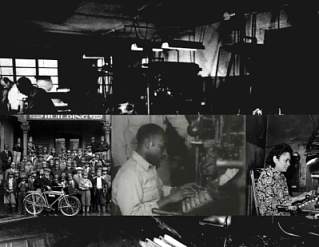 |
Composite image from the Soldiers
Without Swords CD-ROM that accompanies the video. |
|
For the CD-ROM to be a truly effective teaching
tool, teachers would need a comprehensive guide to help them navigate the
complex subject areas and links. I envision exercises that would steer students
to links that amplify and supplement points made in the video. Without an
intimate knowledge of the events that helped shape black history or the
black press, many teachers will have difficulty making optimum use of the
CD-ROM as a supplement to the documentary.
My criticisms of Soldiers Without Swords
are closely linked to two major assumptions that underlie my argument
for the viability of the black press. First, as long as African Americans
experience differential benefits and positions in U.S. society, separate
social structures will be created to serve the needs of those who feel
neglected; hence, separate social institutions including media will be
created. Second, an analysis of the numbers—historical and current—simply
does not support the idea that the black press is dead or dying. The black
press is alive and well today simply because the mostly white press can't
or won't cover the African American community like the black media do.
It never did. It never will. These statements may sound harsh, but my
conclusion has less to do with my judgment of mainstream media and its
intentions, and more to do with the nature of the black press as an active,
integral part of a still largely separate African American social structure.
Reginald Owens
Louisiana Tech University, Ruston
~ End ~ Video and CD-ROM
Review of Soldiers Without Swords: The Black Press
Copyright © 2000, 2001 by The Journal for MultiMedia
History
Comments
| JMMH
Contents |








